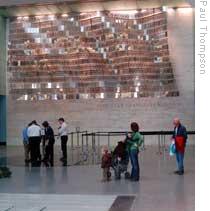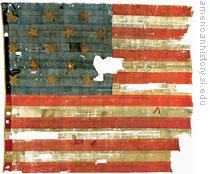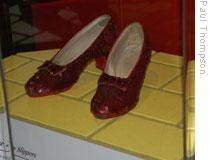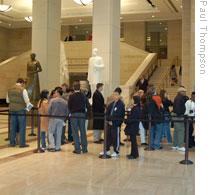VOA慢速英语 2008 1215b
搜索关注在线英语听力室公众号:tingroom,领取免费英语资料大礼包。
(单词翻译)
VOICE ONE:Welcome to THIS IS AMERICA in VOA Special English. I'm Steve Ember.
VOICE TWO:
 |
| A flag made of reflective tiles at the American History Museum |
And I'm Shirley Griffith. This week on our program, we visit Washington's new Capitol Visitor Center and the newly reopened National Museum of American History.
(MUSIC)
VOICE ONE:
The National Mall is a grassy1 area that extends between the Lincoln Memorial and the Capitol building. The Capitol is where Congress meets and where presidents are sworn into office.
The inauguration2 takes place on the West Front of the Capitol as crowds watch from the Mall. Traditionally, parts of the Mall are used to organize the inaugural3 parade on Pennsylvania Avenue from the Capitol to the White House.
But the full length of the Mall will be open to the public for the swearing-in of Barack Obama on January twentieth. Planners expect at least a million people, and perhaps many more, for the inauguration of America's forty-fourth president.
VOICE TWO:
The National Mall is used to a lot of foot traffic. Every year millions of people visit the museums of the Smithsonian Institution that are along the Mall. These include the National Museum of Natural History, the National Air and Space Museum and the National Museum of the American Indian. They also include the Freer and Sackler galleries, which house collections of Asian art.
The Smithsonian museums are all free of charge. James Smithson was an English scientist who died in eighteen twenty-nine. He left half a million dollars to the people of the United States. The purpose was to establish the Smithsonian Institution to increase and spread knowledge.
The National Museum of American History first opened on the Mall in nineteen sixty-four. It became one of the Mall’s most popular museums, with about four million visitors a year.
But six years ago, a study confirmed what many visitors already knew. It found that the building was unappealing and the displays were poorly organized. So officials closed the museum for improvements in two thousand six. It reopened, after a makeover, on November twenty-first.
VOICE ONE:
One of the major criticisms of the museum was that it was too dark. Now, new skylights in the roof let the sun shine in. And visitors are welcomed by a big, silver American flag that appears to be waving. The effect is created by more than nine hundred reflective tiles.
 |
| The Star-Spangled Banner |
And there is a new display for another flag. But this is not just any American flag. This is the Star-Spangled Banner -- the flag that led Francis Scott Key to write the words to what became the national anthem4. It flew over Fort McHenry during the Battle of Baltimore in eighteen fourteen. Americans successfully defended the fort against a British attack.
The Battle of Baltimore was a turning point in the war that began two years earlier. Some people call the War of Eighteen Twelve the "second American revolution."
In the past, the huge flag made of wool and cotton hung in the open air in the museum. In the new display, the Star-Spangled Banner seems suspended in air behind a glass wall. Above are the words of Francis Scott Key.
Key watched the battle and wrote a poem about it. He observed, for example, how "the rockets' red glare, the bombs bursting in air, / Gave proof thro' the night that our flag was still there."
VOICE TWO:
Visitors like Robert and Mary Troy of Los Angeles, California, found the new display very emotional.
ROBERT TROY: "[It will] make you cry. It’s amazing. We brought our grandfather back who had served in World War Two and just the opportunity to see something that is so historic is amazing."
MARY TROY: ”I thought the flag exhibit was breathtaking. It’s a lovely exhibit in the way it’s presented, the lighting5. It’s just gorgeous.”
VOICE ONE:
The National Museum of American History has more than three million objects in its complete collection. The different "themes" in the museum include science and invention, entertainment, war and politics, social issues and transportation and technology.
The Price of Freedom gallery includes a large reproduction of the Declaration of Independence. (A real copy is displayed at the nearby National Archives building on the Mall.) The declaration cut ties with England on July fourth, seventeen seventy-six. Museum volunteer Richard Wilson provides more information about some of the men who signed it.
RICHARD WILSON: "The oldest man to sign the document was Benjamin Franklin. He was seventy years old. The youngest man was from South Carolina, Edward Rutledge; he was twenty-six years old. There were two future presidents [who] signed the document: president number two, John Adams from Massachusetts, and president number three, Thomas Jefferson, who of course wrote this document.
"There's only one man on here out of fifty-six that signed more than his name. And he was from Maryland, and he signed 'Charles Carroll of Carrollton.' And they asked 'Why did you sign "of Carrollton?" And he said 'There are so many Charles Carrolls in Maryland, I didn’t want the king to hang the wrong one.'"
VOICE TWO:
The American History Museum has special areas for children. The Spark Lab, for example, is part of the Science and Innovation area. It deals with the work of inventors. Children and their parents can play games. They can also do science experiments and even try to invent something themselves. The Spark Lab also has an area designed especially for children under five years old.
VOICE ONE:
 |
| Slippers6 from ''Wizard of Oz'' |
One of the most popular parts of the museum is located in the Entertainment, Sports and Music area. "Thanks for the Memories" is where visitors will find the ruby7 slippers that Judy Garland wore in the movie "The Wizard of Oz." The original Kermit the Frog hand puppet from "Sesame Street" is also there.
So are other objects from television and movies -- like "Rocky’s" boxing gloves and an ugly puffy shirt from a "Seinfeld" show.
VOICE TWO:
Many visitors said they liked the new looks of the National Museum of American History, including Scott Cook from Burke, Virginia.
SCOTT COOK: "It’s an improvement, definitely. This used to be a really dark, dingy8 kind of weird9 museum. I never really liked coming here very much. But they’ve opened it up, they put the skylights in, you’ve got sunlight coming in here now, so it’s much better. They always call the Smithsonian 'the nation’s attic10.' This is more of an attic than any of the other museums. This is all kinds of stuff all piled together. You got Archie Bunker’s chair somewhere in here. You got Judy Garland’s ruby slippers, you got Kermit the Frog, you got all this stuff. It’s kind of like digging through somebody’s attic, definitely.”
(MUSIC)
VOICE ONE:
 |
| The Capitol Visitor Center is for people to wait for tours of the building where Congress meets |
On December second, at the United States Capitol building, the Capitol Visitor Center opened to the public.
It was built for two main reasons. One is for security. The other is to make it more pleasant for visitors to wait for tours of the building. In the past, people who wanted to visit the Senate or House of Representatives had to wait outdoors. Washington can get very hot and humid in the summer and very cold and snowy in the winter.
The visitor center was built underground on the east side of the Capitol. It took six years to build and represents the largest addition in the history of the Capitol. The space covers fifty-three thousand square meters. It includes gift shops, restaurants and restrooms for visitors. Also added to the plans were more congressional office space and broadcast studios.
VOICE TWO:
After passing through security, visitors walk down a huge staircase or take an elevator to a huge room called Emancipation11 Hall. Sunlight enters the underground space through two skylights. Around the room are twenty-four statues from the congressional collection provided by the states.
Each statue is of a person who has made a difference in American history. Examples include the first woman elected to Congress, Jeanette Rankin of Montana, and Hawaii's King Kamehameha.
The main statue in Emancipation Hall is a model of the classical female figure that stands on top of the Capitol dome12 -- the Statue of Freedom.
Next, visitors enter the Exhibition Hall, where they can read historic government documents. These include a letter from Thomas Jefferson providing the money for the exploration of North America by Meriwether Lewis and William Clark. And there are six models that show how the Capitol building has changed over time.
VOICE ONE:
The Capitol Visitor Center cost more than six hundred million dollars to build. Some people say that is too much to have spent on a project that started out with the idea for a waiting room. An activist13 group, Citizens Against Government Waste, called it an example of out-of-control spending and mismanagement.
Some visitors on opening day agreed with these criticisms. But others said they liked the Great Hall. Zool Zulkowitz was visiting from Woodmere, New York.
ZOOL ZULKOWITZ: "But to come down to see this hall and be able to look through these skylights at the Capitol dome, which I think entrances any one of us whether you come from Washington or anywhere in the world, is just breathtaking. And then to look below and to see the model of the Statue of Freedom, it’s an exquisite14 sculpture. Here in Emancipation Hall, the great clean lines of these columns and the openness of the hall -- to see the statues that have been chosen to be placed here, is really remarkable15 to me."
VOICE TWO:
Our program was written by Nancy Steinbach and produced by Caty Weaver16. I'm Shirley Griffith.
VOICE ONE:
And I'm Steve Ember. Transcripts17, MP3s and podcasts of our programs are at voaspecialenglish.com. Join us again next week for THIS IS AMERICA in VOA Special English.
 收听单词发音
收听单词发音 




